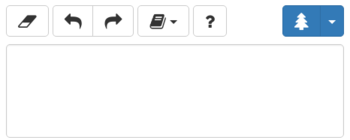KinMap accepts input as simple as a list of kinase names and creates the corresponding annotations
using a default style (red filled circles).
To annotate a set of kinases, simply list them and click Plot!
Kinase Names.
KinMap employs a unique identifier for each kinase, termed the
"xName", which you can find listed
here.
KinMap accepts other kinase names and automatically resolves them to the corresponding xNames
(see
Validate Names).
You can customize the kinase annotation using a concise style directive that defines its
shape (circle, triangle, square, pentagon),
size, fill-color, stroke-color, and stroke-width.
Directives start with the @ symbol and apply the encoded style to all succeeding kinases,
until another directive is encountered.
Take this as an example:
@ 3 : 25 : yellow : red
ABL1, CHK2
This will annotate ABL1 and CHK2 kinases with triangles, 25-pixels in size, with yellow filling and red border.
For a quick reminder on input syntax, click the Help
button in the text-input panel.
The Examples button
shows three illustrative inputs with varying degrees of sophistication.
Input Syntax
Kinase names
- You can use any of the alternative kinase names to refer to the kinase of interest
- The built-in parsing function can recognize names
used by Manning et al.,
recommended by the UniProt Consortium,
approved by the HUGO Gene Nomenclature Committee,
used by Kinome Render;
as well as any of the alternative names listed in these resources.
- Kinase names can be separated by commas, semicolons, colons or written on separate lines
Directives
- Directives can be used to change the color, size, and shape of the annotation
- Directives start with @ mark and contain at least three segments separated by colons :
- Default annotation: @0:20:red:black:1.5
- Syntax: @ shape : size : fill color : stroke color : stroke width
- Shapes:
(0) circle, (3) triangle, (4) square (5) pentagon
- Colors:
any recognized SVG color name
or three numbers (rgb code) separated by commas or spaces, e.g. 0,0,0 (black) and 255,255,255 (white)
- The latest annotation style will be used for lines that follow until the next directive
Comments
- Lines starting with # will be skipped (as comments)
- All lines which do not start with # or @ will be parsed as kinase names.
